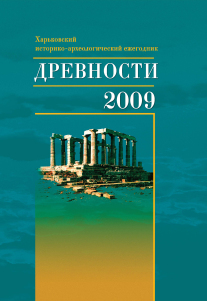Могильник у с. Песочин под Харьковом в контексте истории древних кочевников Южного Урала
Анотація
Резюме
Гуцалов C. Ю. Могильник у c. Пісочин під Харковом у контексті історії стародавніх кочовиків Південного Уралу
Дана стаття присвячена аналізу матеріалів розкопок курганів кінця V—IV ст. до н. е. у с. Пісочин під Харковом.Матеріал, який розглядається, характеризує, в першу чергу, військову еліту кочовиків Сіверського Донця. Історико-культурні паралелі з синхронних поховань степу і лісостепу Східної Європи і віддаленіших територій дозволяє стверджувати, що поява цього некрополя пов’язана в цілому з розвитком історичної ситуації в Євразійських степах в середині I тис. до н. е. Поховальні пам’ятки подібного типу зустрічаються на Середньому і Нижньому Доні, в Нижньому Поволжі, в Придніпров’ї. З іншого боку вони тісно пов’язані з культурою еліти племен Південного Уралу кінця VI—V ст. до н. е. Є сенс говорити про розповсюдження військових поховань в степовій і лісостеповій зонах східної Європи в результаті міграції населення з східних регіонів степової смуги Євразії, і, при цьому, значна роль належала степовим племенам Південного Уралу.
Ключові слова: с. Пісочин, шатрові й зрубові конструкції, ортогональне положення, орієнтування головою на південь.
Summary
S. Gutsalov. The Groves Near the Village Pesochin Under Kharkov in the Ccontext of the Soutn Ural Ancient Nomads History
The given article is devoted to the analysis of excavation materials of the Scythian burial ground near Kharkov, village Ppesochin. These materials give a characteristic to the Severski Donets forest-steppe nomads military elite. Historical and cultural comparisons of synchronous buried in steppe and forest-steppe of Eastern Europe and farther areas suggests that the emergence of the necropolis associated with the development of the whole historical situation in the Eurasian steppes in the middle of the I thousand B.C. The burial grounds of the same kind occur on the Middle Done and behind the Volga and the Down Done. On the other hand, they are closely connected to the culture of the South Ural nomadic elite at the end of VI—V centuries B.C. There are pints to speak about the spreading of military necropolis in the steppe and forest-steppe areas of the East Europe as a result of migration of the population from the more Eastern Eurasian regions, where the main role was possessed to the nomads of the Ural Steppe.
Key words: vill. Ppesochin, tent-frame and wooden construction, orthogonal position, the south orientation of the head.




